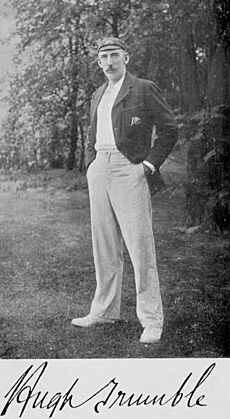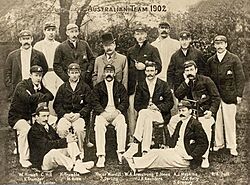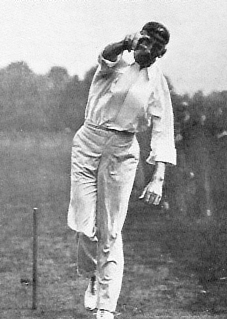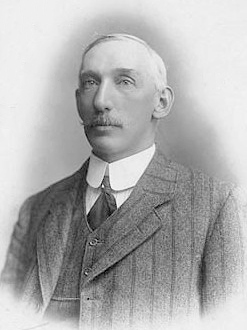Hugh Trumble facts for kids
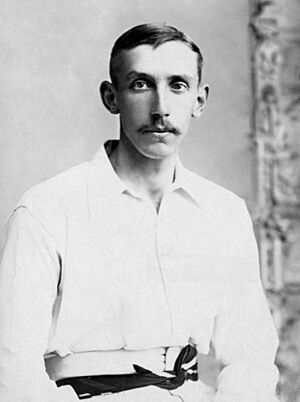
Trumble in around 1893
|
||||||||||||||||||||||||||||||||||||||||
| Personal information | ||||||||||||||||||||||||||||||||||||||||
|---|---|---|---|---|---|---|---|---|---|---|---|---|---|---|---|---|---|---|---|---|---|---|---|---|---|---|---|---|---|---|---|---|---|---|---|---|---|---|---|---|
| Full name |
Hugh Trumble
|
|||||||||||||||||||||||||||||||||||||||
| Born | 19 May 1867 Collingwood, Colony of Victoria |
|||||||||||||||||||||||||||||||||||||||
| Died | 14 August 1938 (aged 71) Hawthorn, Victoria, Australia |
|||||||||||||||||||||||||||||||||||||||
| Height | 1.93 m (6 ft 4 in) | |||||||||||||||||||||||||||||||||||||||
| Batting | Right-handed | |||||||||||||||||||||||||||||||||||||||
| Bowling | Right-arm off-spin | |||||||||||||||||||||||||||||||||||||||
| Role | All-rounder | |||||||||||||||||||||||||||||||||||||||
| Relations | Billy Trumble (brother) | |||||||||||||||||||||||||||||||||||||||
| International information | ||||||||||||||||||||||||||||||||||||||||
| National side | ||||||||||||||||||||||||||||||||||||||||
| Test debut (cap 59) | 21 July 1890 v England | |||||||||||||||||||||||||||||||||||||||
| Last Test | 8 March 1904 v England | |||||||||||||||||||||||||||||||||||||||
| Domestic team information | ||||||||||||||||||||||||||||||||||||||||
| Years | Team | |||||||||||||||||||||||||||||||||||||||
| 1887–1904 | Victoria | |||||||||||||||||||||||||||||||||||||||
| Career statistics | ||||||||||||||||||||||||||||||||||||||||
|
||||||||||||||||||||||||||||||||||||||||
|
Source: Cricinfo, 9 February 2008
|
||||||||||||||||||||||||||||||||||||||||
Hugh Trumble (born May 19, 1867 – died August 14, 1938) was a famous Australian cricket player. He played 32 Test matches for Australia between 1890 and 1904. He was a great all-rounder who bowled and batted well.
Trumble was even the captain of the Australian team for two Test matches, winning both of them! He took 141 wickets in Test cricket. This was a world record when he retired. He is also one of only four bowlers in Test cricket history to take a hat-trick twice. A hat-trick is when a bowler takes three wickets with three balls in a row.
Many people who watched cricket back then, including the famous Wisden Cricketers' Almanack, thought he was one of Australia's best bowlers. He was named a Wisden Cricketer of the Year in 1897. In 2004, he was added to the Australian Cricket Hall of Fame.
Trumble was tall and thin and bowled off spin (a type of bowling). He bowled faster than most spin bowlers. His height and long fingers helped him a lot. He was especially good on softer cricket pitches in England. But his accuracy and different speeds also helped him take wickets in Australia. He was a reliable batsman lower down the batting order. He was also a great fielder in the slips position. People saw him as a smart player who understood the game well. He was liked by his teammates and opponents.
Trumble played his first Test match during Australia's tour of England in 1890. But he didn't become a regular player until the 1896 tour of England. In 1899, when the Australian team toured England again, Trumble had an amazing tour. He scored 1,183 runs and took 142 wickets. Only George Giffen had done this before him on an English tour. He became Australia's captain in 1901–02 when the usual captain, Joe Darling, was busy. Trumble retired after the 1902 tour but was asked to come back in 1903–04. In his very last Test match, he took his second hat-trick in front of his home crowd in Melbourne.
Outside of cricket, Trumble worked for the National Australia Bank. He became a branch manager. In 1911, he became the secretary of the Melbourne Cricket Club (MCC). He helped make the Melbourne Cricket Ground (MCG) a huge stadium. He stayed in this job until he passed away in 1938 at age 71.
Contents
Early Life and Cricket Start
Hugh Trumble was born in Collingwood, Victoria, a part of Melbourne, in 1867. His father, William, was from Ireland and worked as a superintendent at a hospital. His mother, Elizabeth, was from Scotland. Hugh's older brother, Billy, also played Test cricket for Australia. His younger brother, Thomas, worked for the government.
Trumble lived in Ararat for a while before moving back to Melbourne. He went to Hawthorn Grammar School. He started playing cricket for Kew Cricket Club. His father, William, loved cricket and even made a cricket pitch at their home. He would put a feather on the pitch and tell his sons to aim for it when bowling. This helped Hugh become very accurate. He later said he couldn't always hit the feather, but he was "always pretty close to it."
Trumble joined the Melbourne Cricket Club in the 1887–88 cricket season. He quickly became successful. He took 36 wickets that season, with a great average of 6.77 runs per wicket. This was the best at his club. He played his first first-class cricket match for Victoria that same season. He played against an English team. In his first match for Victoria against another Australian team, New South Wales, he took seven wickets for 52 runs in the first innings.
Test Cricket Journey
First Steps in Test Cricket
In late 1889, Trumble had a tough time taking wickets. This worried him because the Australian team for the 1890 tour of England was being chosen. He was anxious about his performance. Trumble was selected for the team. He finished that season with 27 wickets.
The Australian team that toured England in 1890 was quite new. They missed the skills of George Giffen, who decided not to go. The Australians won 13 matches, lost 16, and drew 9. Trumble made his Test cricket debut in the First Test against England at Lord's Cricket Ground. He only took one wicket in that match. He scored 1 run not out in the first innings and 5 runs in the second. He kept his place for the Second Test but didn't take any wickets. The Third Test was rained out. Wisden Cricketers' Almanack said that people expected a lot from Trumble, but his bowling lacked "devil" and variety.
Trumble was not chosen for the Australian team in 1891–92. He returned to the team for the 1893 tour of England. Before the Test matches, he took many wickets in other games. He played in all three Test matches in 1893, taking 6 wickets. He also scored 774 runs in other first-class matches, including one century. Wisden noticed a big improvement in his bowling and batting.
When the English team visited Australia in 1894–95, Trumble played only one Test match. This was the Second Test in Melbourne. England scored 75 runs in their first innings, with Trumble taking 3 wickets. But England came back strong in their second innings, scoring 475 runs to win. Trumble didn't take any wickets in that innings.
Becoming a Key Player
Trumble was chosen for the Australian team to tour England in 1896. Some experts doubted his selection because he hadn't played well domestically. But it was on this tour that Trumble finally became a permanent player for Australia. Wisden said that it was his third visit to England that made people realize he was one of Australia's "great bowlers." That season, Trumble took 148 wickets. He was seen as Australia's best bowler. Wisden said his strength was combining spin with great accuracy.
England won the First Test. The Second Test was very close. Australia needed 125 runs to win. Trumble and Kelly batted together with only 3 wickets left and 25 runs still needed. They managed to score the winning runs, mainly in singles. Trumble scored 17 runs not out and took 4 wickets in the match. In the Third Test, Trumble took 6 wickets for 59 runs in England's first innings. He then took another 6 wickets for 30 runs in their second innings. But England won the Test and kept the Ashes. In the three Tests, Trumble took 18 wickets.
Trumble played in every Test of the 1897–98 series against England in Australia. Australia won the series four Tests to one. Trumble took 19 wickets and scored 170 runs in the series. In the Fourth Test, Trumble and Clem Hill made a big partnership of 165 runs. Wisden called this a turning point.
The 1899 Australian tour of England was amazing for Trumble. He scored 1,183 runs and took 142 wickets. He was only the second Australian to achieve this "double" feat on an English tour. In the Test series, Trumble took 15 wickets and scored 232 runs. Wisden said that if he wasn't a bowler, he would have been a "great batsman." Australia won the Second Test and kept the Ashes. Trumble played very well in the Third Test, taking 5 wickets and scoring 56 runs.
Hat-Tricks and Leading the Team
At 34 years old, Trumble was chosen to captain the Australian team in 1901–02. This happened when Joe Darling had to leave to manage his farm. Australia won the two Tests Trumble captained, winning the series four Tests to one. In the Second Test in Melbourne, Trumble took a "hat-trick". He got Arthur Jones, John Gunn, and Sydney Barnes out with three balls in a row. This helped Australia win by 229 runs.
In the Third Test, Trumble took 6 wickets and scored 62 runs not out. Australia won by 4 wickets. As captain, Trumble even tried to open the batting in the next Test, but it didn't work out. Australia won the Fifth Test, with Trumble taking 5 wickets in the first innings and 3 more in the second. Trumble and Monty Noble were Australia's best bowlers in the series, taking 60 wickets together.
Trumble's last cricket tour of England was in 1902. He broke his thumb early in the tour, missing a month of play. But when he returned for the last three Tests, he took 26 wickets. In the Fourth Test, Trumble took 10 wickets in the match. This included 6 wickets in the second innings, helping Australia win by just 3 runs. In the Fifth Test, Trumble scored 64 runs and took 8 wickets in England's first innings. He took 4 more wickets in the second innings, but England still won. Wisden praised Trumble's bowling, saying he bowled "perhaps better than ever."
After playing one Test match against South Africa, Trumble retired from Test cricket at age 35. But when Australia lost the First Test to England in 1903–04, Trumble was asked to come back. He was immediately successful, taking 4 wickets in the first innings and 5 in the second. He played in the remaining four Tests, taking 24 wickets.
His final Test match was described as a "dramatic and memorable farewell." In front of his home fans in Melbourne, he took 7 wickets for 28 runs, including his second hat-trick. He got Bernard Bosanquet, Plum Warner, and Dick Lilley out in a row. He then took the wicket of Ted Arnold, ending the match and his amazing international career.
Playing Style and Personality
Hugh Trumble was very tall, about 6 feet 4 inches (193 cm). He had a long face, big ears, and a large nose. His long arms and strong fingers helped him bowl. Cricket writer Ray Robinson said Trumble looked like a painting by El Greco, with his "lantern shaped head set on a column of a neck." English cricketer Plum Warner called him "That great camel, Hughie Trumble."
When he bowled, Trumble used his height to his advantage. His teammate Monty Noble described his bowling action as "sidelong and insinuating." He bowled off spin with excellent accuracy and at a medium pace. He could also swing the new ball. He had a clever slower ball that tricked many batsmen. He loved bowling on English pitches because they helped his spin. In Australia, he worked harder on firmer pitches, using changes in speed and accuracy. He claimed he could land the ball on a saucer 17 meters away five times out of six! W. G. Grace called him "the best bowler Australia has sent us."
Trumble was also known as a great slips fielder because of his long, flexible fingers. He was the first player to take 20 catches in an Australian season. English cricketer Johnny Douglas joked that Trumble should be "up trees in the bush" because of his long fingers. He practiced fielding by catching a tennis ball thrown against a brick wall. This helped him learn to let the ball fall safely into his hands.
Trumble was known for being very smart on the field. C. B. Fry said he was the "most long-headed, observant and acute judge of the game." Once, when captaining his state team, Victoria, he purposely bowled two wide balls that went for four runs each. He did this to avoid his tired bowlers having to bowl again immediately. He was respected by his teammates and opponents. New Zealand cricketer Dan Reese said Trumble's "subtle humour, his fund of cricket stories, his kindness, and, above all, his judgment, made him a man of exceptional character."
He was also known for playing practical jokes. On a ship to England, Trumble pretended to coach people in deck games. He made them twist into funny positions, which amused his teammates. To keep the joke going, he would use the same funny stance himself in his own games.
Life After Cricket
Trumble started working at the National Australia Bank in 1887. His cricket career meant he was often away, so his banking career moved slowly. After each of his five tours of England, he found younger colleagues had been promoted ahead of him. Still, he became an accountant in 1903. After retiring from cricket in 1908, he became a branch manager.
Trumble was very loyal to the Melbourne Cricket Club (MCC). He was on their committee from 1900 to 1911 and became a life member in 1904. In 1911, he left the bank to become the MCC club secretary. He held this important job for 27 years until he passed away. In this role, he helped bring the club and the Victorian Cricket Association closer together. He also helped bring talented cricketers to the club. During his time as secretary, the Melbourne Cricket Ground was made much bigger, able to hold over 70,000 people.
Trumble was also a well-known writer about cricket. He was always happy to talk to journalists. He sometimes helped choose players for the Victorian cricket team. In 2001, Trumble was chosen for the Melbourne Cricket Club's Team of the Century. In 2004, he was inducted into the Australian Cricket Hall of Fame for his great contributions to Australian cricket.
In 1899, when he was 31, Trumble met Florence Christian, who was 19. They fell in love and got married in 1902. Their wedding was planned so they could have their honeymoon during the Australian cricket tour of England. An injury to his thumb meant Trumble had some time off from cricket, which made his new wife happy. They had eight children together: six sons and two daughters. One of their sons, Robert, became a famous musician and writer. He dedicated his first book, The Golden Age of Cricket, to his father. Hugh Trumble passed away at his home in Hawthorn, Melbourne, at age 71, from a heart attack.
Images for kids


